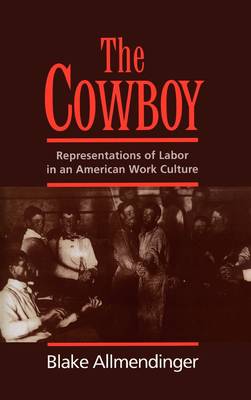
- Afhalen na 1 uur in een winkel met voorraad
- Gratis thuislevering in België vanaf € 30
- Ruim aanbod met 7 miljoen producten
- Afhalen na 1 uur in een winkel met voorraad
- Gratis thuislevering in België vanaf € 30
- Ruim aanbod met 7 miljoen producten
Zoeken
The Cowboy
Representations of Labor in an American Work Culture
Blake Allmendinger
Hardcover | Engels
€ 254,45
+ 508 punten
Omschrijving
What are the connections between cattle branding and Christian salvation, between livestock castration and square dancing, between cattle rustling and the making of spurs and horsehair bridles in prison, between children's coloring books and cowboy poetry as it is practiced today? The Cowboy uses literary, historical, folkloric, and pop and cultural sources to document ways in which cowboys address religion, gender, economics, and literature. Arguing that cowboys are defined by the work they do, Allmendinger sets out in each chapter to investigate one form of labor (such as branding, castration, or rustling) in the cowboy's "work culture". He looks at early oral poems recited around campfires, on trail drives, at roundups, and at home in ranch bunkhouses, and at later poems, histories, and autobiographies written by cowboys about their work - most of which have never before received scholarly attention. Allmendinger shows how these texts address larger concerns than the work at hand - including art, morality, spirituality, and male sexuality. In addition to spotlighting little-known texts, art, and archival sources, The Cowboy examines the works of Mark Twain, John Steinbeck, Willa Cather, Louis L'Amour, Larry McMurtry, and others. Unique among studies of the American cowboy, Allmendinger's study looks at what cowboys thought of themselves, and the ways in which they represented those thoughts in their own prose, poetry, and artifacts. Richly illustrated with photographs of cowboys at work and at play, many previously unpublished, The Cowboy will interest scholars of American literature and history, and American Studies, as well as those interested in Western history and culture, folklore, and gender studies.
Specificaties
Betrokkenen
- Auteur(s):
- Uitgeverij:
Inhoud
- Aantal bladzijden:
- 216
- Taal:
- Engels
Eigenschappen
- Productcode (EAN):
- 9780195072433
- Verschijningsdatum:
- 10/12/1992
- Uitvoering:
- Hardcover
- Formaat:
- Genaaid
- Afmetingen:
- 159 mm x 235 mm
- Gewicht:
- 521 g

Alleen bij Standaard Boekhandel
+ 508 punten op je klantenkaart van Standaard Boekhandel
Beoordelingen
We publiceren alleen reviews die voldoen aan de voorwaarden voor reviews. Bekijk onze voorwaarden voor reviews.








